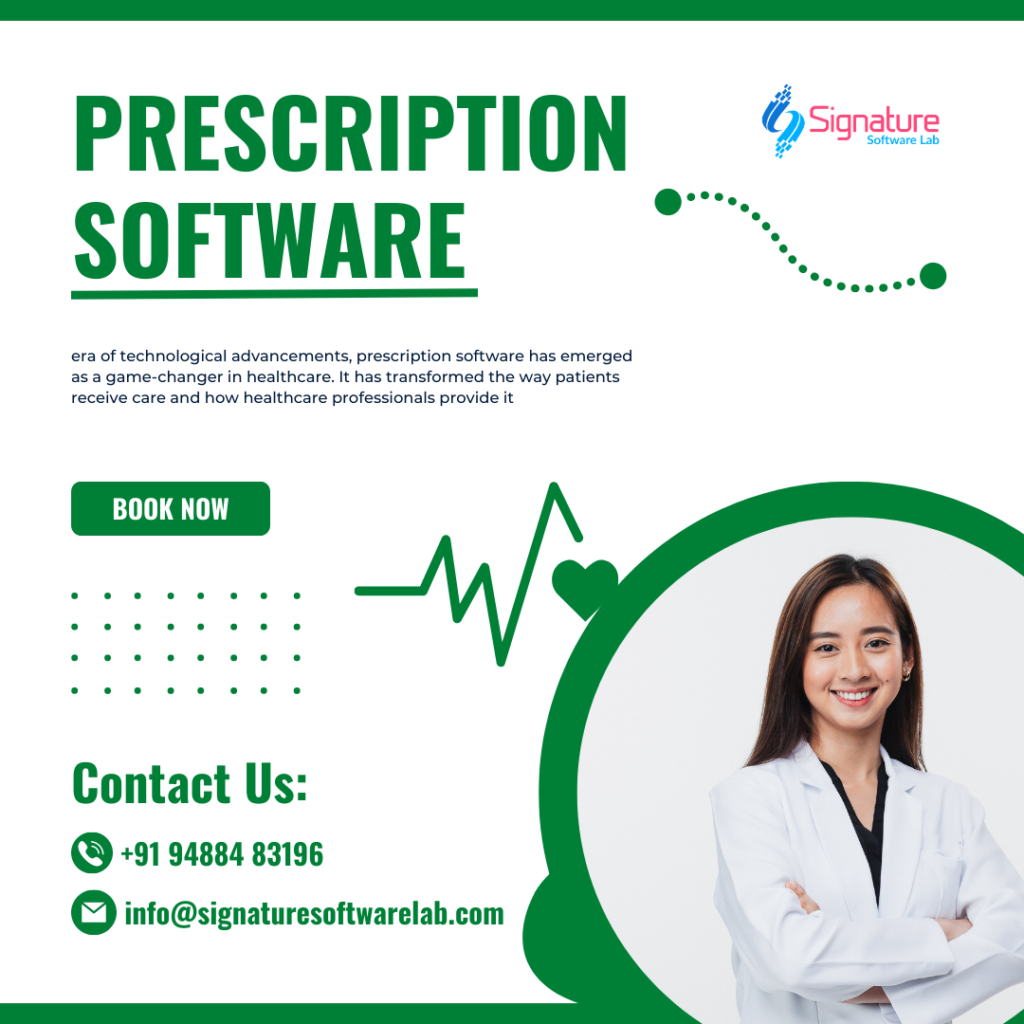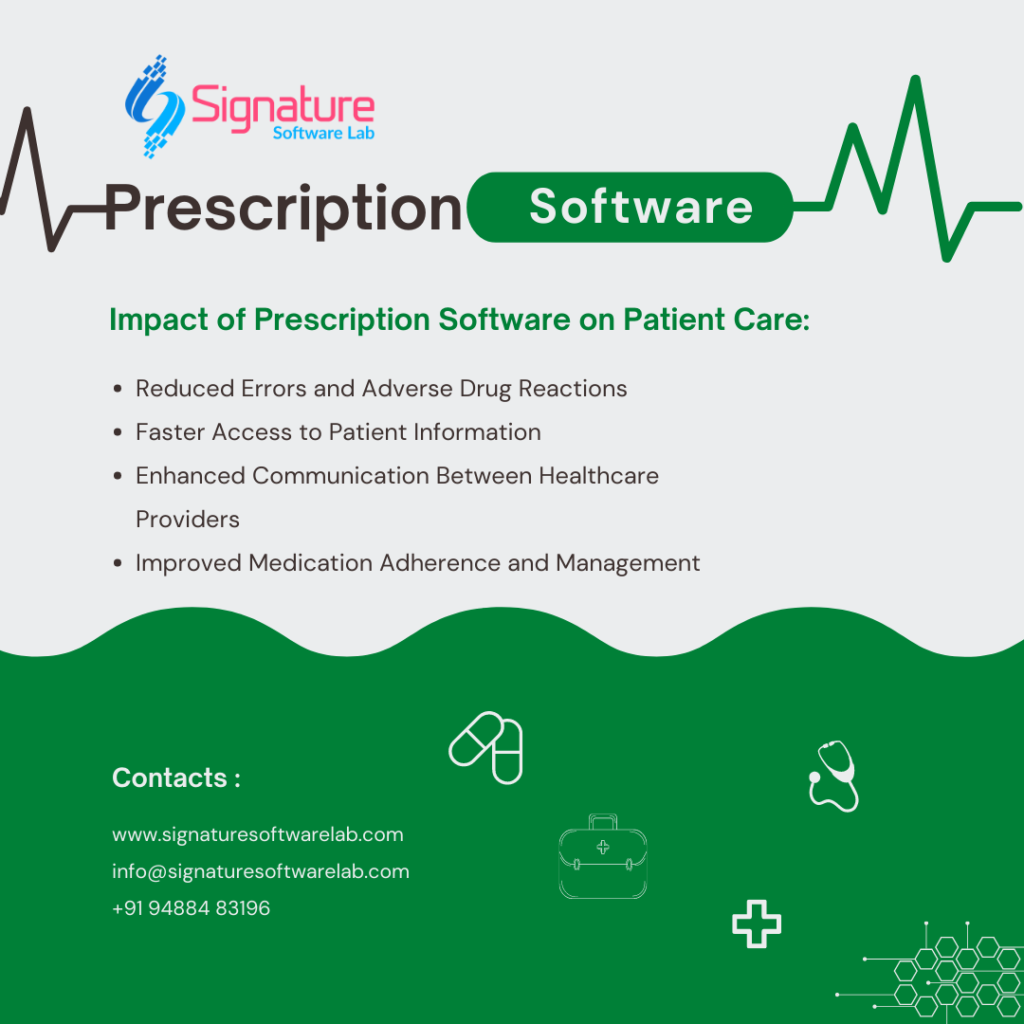In this era of technological advancements, prescription software has emerged as a game-changer in healthcare. It has transformed the way patients receive care and how healthcare professionals provide it. In this article, we delve into the definition, historical context, advantages, types, implementation, impact, challenges, and future prospects of prescription software in patient care.

Table of Contents
What is Prescription Software
The software refers to a digital solution that enables healthcare providers to create, manage, and transmit prescriptions electronically. Gone are the days of paper-based prescriptions that were prone to errors and inefficiencies. With prescription software, healthcare professionals can streamline the prescribing process, improve accuracy, and enhance patient outcomes.
Historical Context: From Paper to Digital
To appreciate the significance of patient care software, we must understand the historical context. Traditional paper-based prescriptions involved handwritten instructions and manual record-keeping. This antiquated method often led to illegible prescriptions, misinterpretations, and delayed access to critical patient information.
In contrast, digital prescriptions offer a modern approach that addresses these limitations. They facilitate seamless communication, instant access to patient data, and real-time monitoring of medication adherence. This transition from paper to digital represents a pivotal moment in the evolution of patient care.
Advantages:
Prescription software brings forth a myriad of benefits that revolutionize patient care. Let’s explore some of its key advantages:
- Accuracy: By eliminating illegible handwriting and reducing human errors in prescription creation, the software ensures greater precision in medication instructions, minimizing the risk of adverse drug reactions and improving patient safety.
- Increased Efficiency: Prescription software streamlines the prescription process, allowing healthcare professionals to create, review, and transmit prescriptions with ease. This automation saves time, enhances workflow, and improves overall efficiency in healthcare settings.
- Improved Accessibility and Ease of Use: Digital prescriptions can be accessed from anywhere, at any time, providing healthcare professionals with instant access to patient information. Additionally, the intuitive interfaces of prescription software make it user-friendly for both clinicians and patients.
- Cost-effectiveness: The adoption of prescription software reduces costs associated with paper, printing, storage, and manual record-keeping. It optimizes resource allocation, enabling healthcare organizations to allocate their budgets more efficiently.
Different Types:
Prescription software encompasses various types of digital solutions designed to optimize different aspects of patient care. The most prominent types include:
- Electronic Health Records (EHR): EHR systems integrate prescription functionality into a comprehensive electronic patient record. They enable seamless information exchange between healthcare providers and enhance care coordination.
- E-Prescribing: E-prescribing software focuses specifically on the electronic creation and transmission of prescriptions. It enables real-time access to formularies, medication histories, and drug interaction alerts, promoting safe and efficient prescribing.
- Medication Management Systems: These systems offer advanced features to manage medication regimens effectively. They may include medication reconciliation, dosage reminders, and medication adherence monitoring, ensuring patients take their medications as prescribed.
Implementation of Software in Patient Care
The successful implementation of software requires careful consideration of several factors. Here are some crucial steps for effective integration:
- Integration with Electronic Health Records: Prescription software should seamlessly integrate with existing EHR systems to ensure efficient information exchange and continuity of care.
- Alignment with HIPAA Compliance Standards: Healthcare organizations must prioritize patient privacy and security. Prescription software should adhere to the Health Insurance Portability and Accountability Act (HIPAA) regulations to protect patient data.
- Staff Training and Support: Adequate training and ongoing technical support are crucial for a smooth transition to prescription software. Healthcare professionals should be equipped with the necessary skills to utilize the software effectively.
- Patient Education and Engagement: It is essential to educate patients about the benefits of digital prescriptions and engage them in the process. This empowers patients to take an active role in managing their medications and ensures better treatment outcomes.
Impact of Prescription Software on Patient Care
The integration of software into patient care has brought about significant improvements across various domains. Let’s explore the transformative impact it has had:

- Reduced Errors and Adverse Drug Reactions: It eliminates the risk of illegible handwriting and offers built-in safety checks, such as allergy alerts and drug interaction warnings. This leads to a substantial reduction in medication errors and adverse drug reactions.
- Faster Access to Patient Information: Digital prescriptions provide immediate access to patient records, enabling healthcare providers to make informed decisions promptly. This results in expedited diagnosis, treatment, and overall care delivery.
- Enhanced Communication Between Healthcare Providers: It promotes seamless communication and collaboration among healthcare professionals. It enables secure messaging, facilitates interdisciplinary care, and ensures accurate medication information exchange.
- Improved Medication Adherence and Management: Enhances medication adherence by providing automated reminders, detailed instructions, and refill alerts. This empowers patients to adhere to their prescribed regimens, leading to better health outcomes.
Challenges and Limitations:
Despite its remarkable benefits, prescription software does face some challenges and limitations:
- Security Concerns: The digital nature of prescriptions raises concerns about data security and privacy breaches. Healthcare organizations must prioritize robust security measures to protect patient information.
- Resistance to Change from Healthcare Professionals: The adoption of new technology can be met with resistance from healthcare professionals who are accustomed to traditional methods. Overcoming this resistance requires comprehensive training and effective change management strategies.
- Technical Difficulties and Usability Issues: It may encounter technical glitches or have complex interfaces that hinder seamless usage. User-friendly designs and continuous software improvements are necessary to address these challenges.
- Limited Access in Rural Areas and Developing Countries: While the software has transformed patient care in many regions, limited internet connectivity and infrastructure pose challenges to its adoption in rural areas and developing countries. Bridging this digital divide is essential for equitable healthcare delivery.
Future of Prescription Software in Patient Care
This software holds immense potential for the future of patient care. Here are some key trends that will shape its development:
- Artificial Intelligence and Machine Learning Integration: AI and machine learning algorithms will enable predictive prescribing, personalized treatment plans, and intelligent medication management systems that adapt to patients’ individual needs.
- Personalization of Medication Management: The software will evolve to accommodate individual patient preferences, lifestyles, and specific health conditions. Tailored medication regimens will lead to optimized treatment outcomes.
- Collaborative Care and Patient Empowerment with mHealth Apps: Mobile health applications will integrate with prescription software to enhance patient engagement, enable remote monitoring, and foster collaborative care between patients and healthcare providers.
- Potential to Reduce Healthcare Costs and Improve Outcomes: The efficient use of software can result in cost savings by reducing medication errors, preventing hospital readmissions, and improving overall health outcomes. This, in turn, has the potential to alleviate the financial burden on healthcare systems.

Case Studies and Examples
Numerous hospitals and clinics have successfully implemented healthcare software, resulting in improved patient care and safety. Patient experiences and feedback serve as a testament to its effectiveness.
Ethical and Legal Considerations
This raises ethical and legal considerations that must be addressed. Protecting patient privacy, clarifying liability issues, and ensuring compliance with regulatory frameworks are paramount.
Comparison with Traditional Methods
Surpasses traditional methods such as paper-based, faxed, or phone prescriptions in terms of accuracy, efficiency, accessibility, and cost-effectiveness.
Cost and Business Considerations
Healthcare organizations must carefully evaluate the return on investment of prescription software. Pricing models for software vendors, insurance coverage, and reimbursement mechanisms are critical factors to consider.
Impact on Healthcare Industry and Economy
It contributes to job creation, promotes technological utilization in healthcare, and has the potential to increase access to care while reducing disparities. It positively impacts both the healthcare industry and the economy as a whole.
Global Perspective
Adoption in developing countries requires attention to cultural and linguistic considerations. International collaboration can address challenges and leverage opportunities for knowledge exchange and implementation.
Future Research Directions
Continued research is vital to assess patient outcomes, satisfaction levels, long-term cost-effectiveness, and integration with telemedicine and remote patient monitoring.
Summary
Prescription software has revolutionized patient care by improving accuracy, efficiency, accessibility, and cost-effectiveness. It has reduced errors, enhanced communication, and empowered patients to better manage their medications. Despite challenges, prescription software holds great promise for the future of healthcare.
FAQs
What is prescription software?
It refers to digital solutions that enable healthcare providers to create, manage, and transmit prescriptions electronically, streamlining the prescribing process and enhancing patient outcomes.
How does prescription software benefit patients?
The benefits patients by reducing medication errors, providing faster access to patient information, improving communication between healthcare providers, and promoting medication adherence and management
What are some common challenges when implementing prescription software in healthcare?
Common challenges include security concerns, resistance to change from healthcare professionals, technical difficulties, usability issues, and limited access in rural areas and developing countries.
What is the future of prescription software in healthcare?
The future of prescription software in healthcare lies in the integration of artificial intelligence and machine learning, personalization of medication management, collaborative care with mHealth apps, and the potential to reduce costs and improve outcomes.
